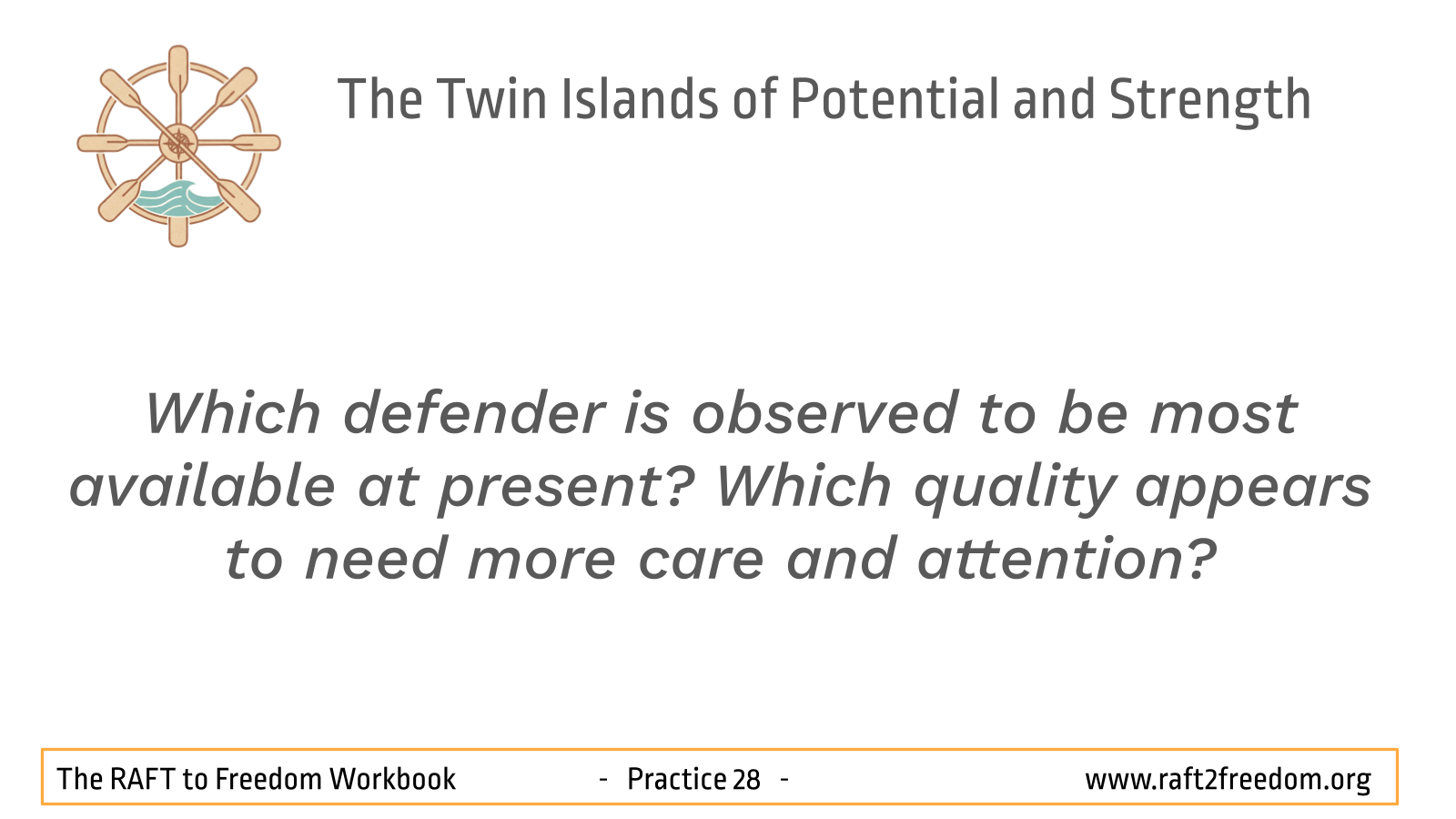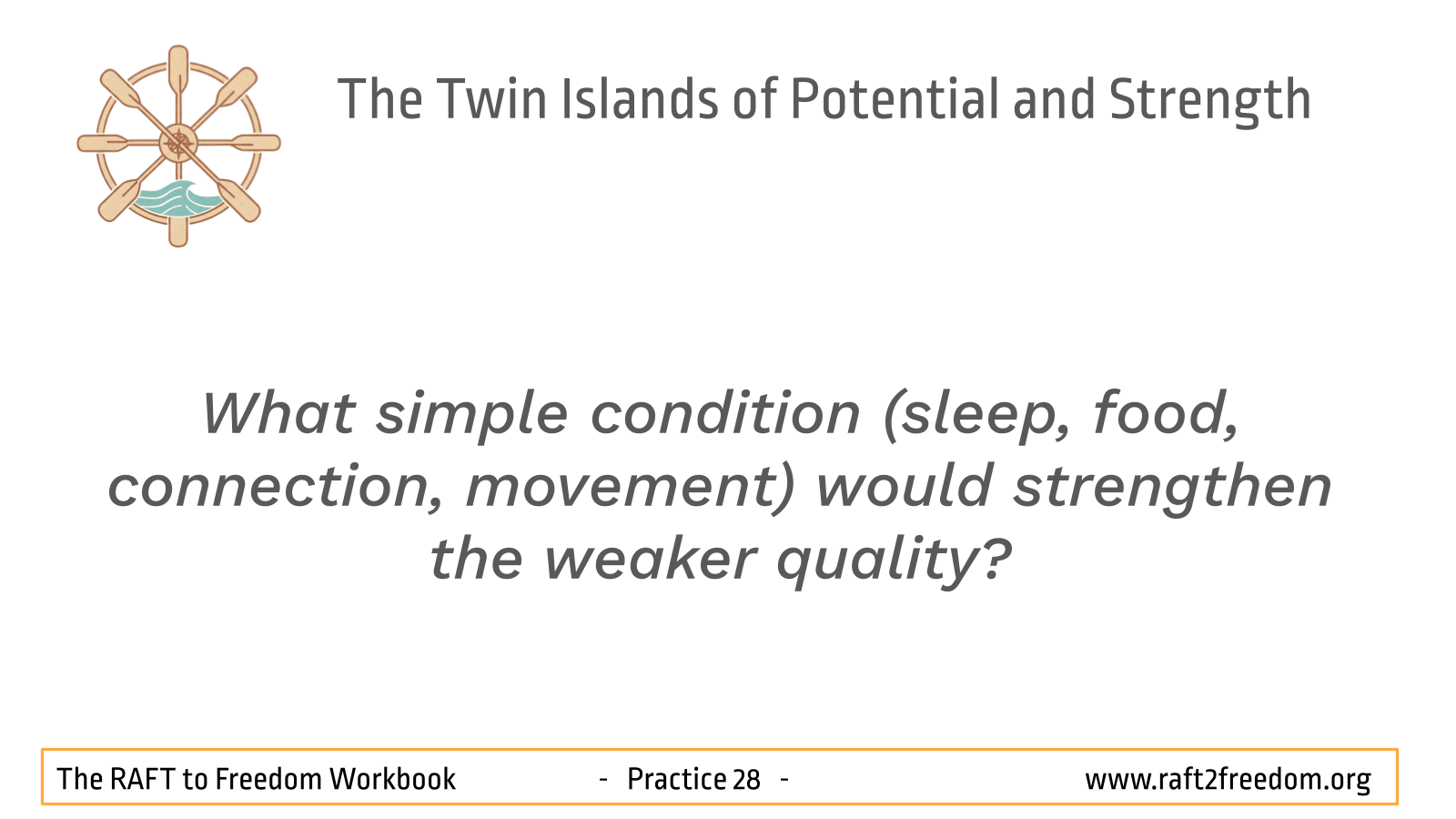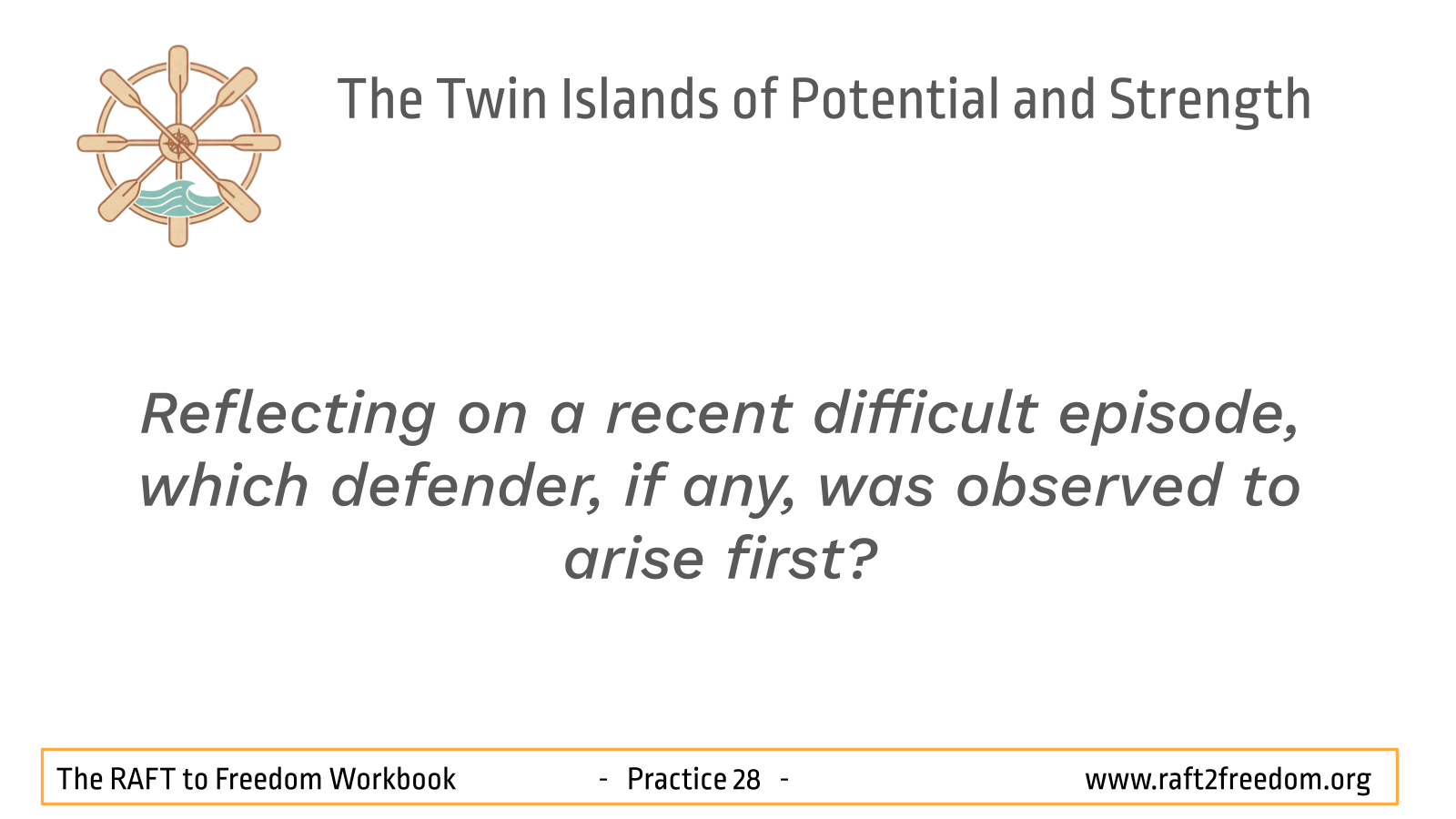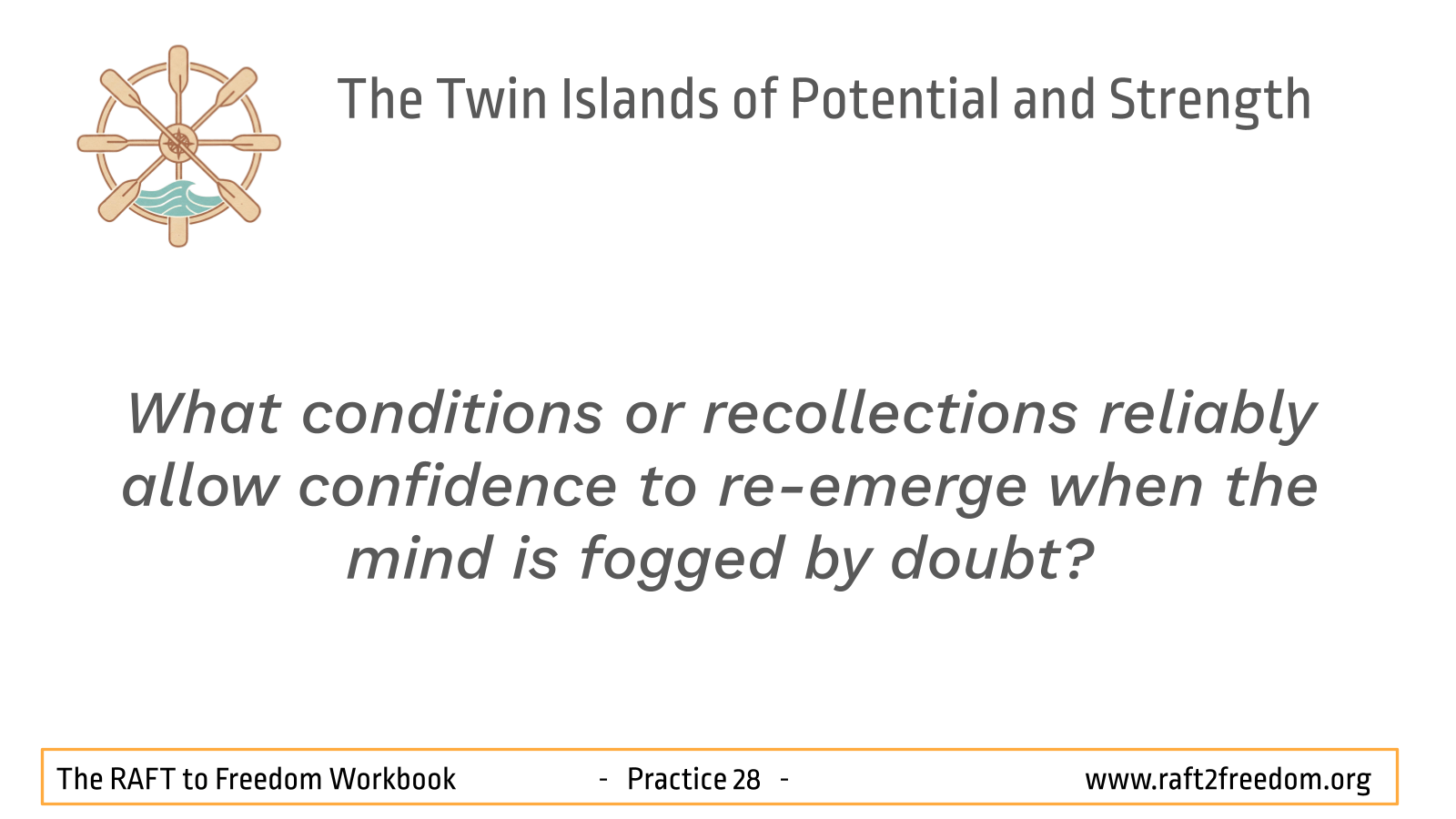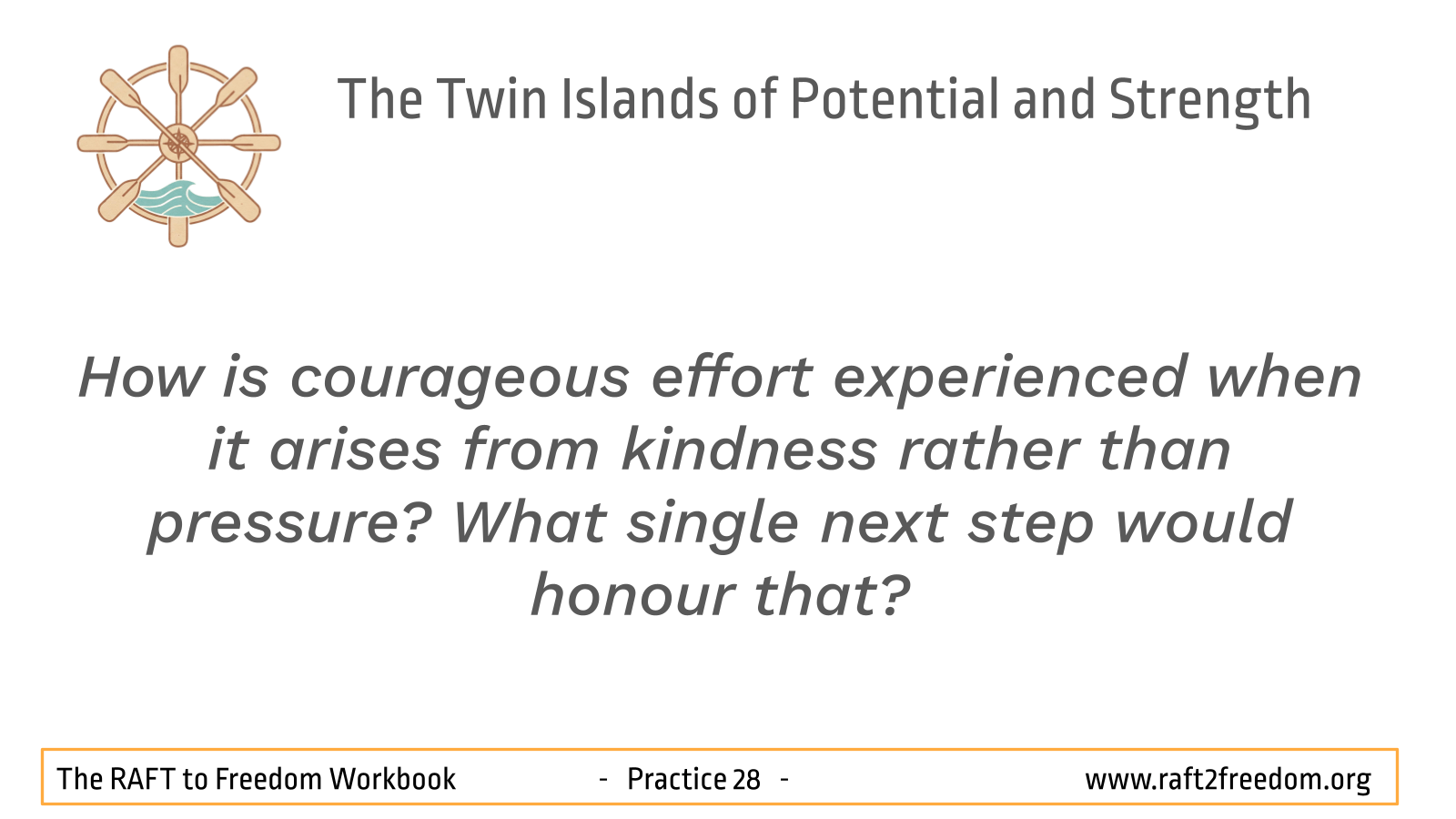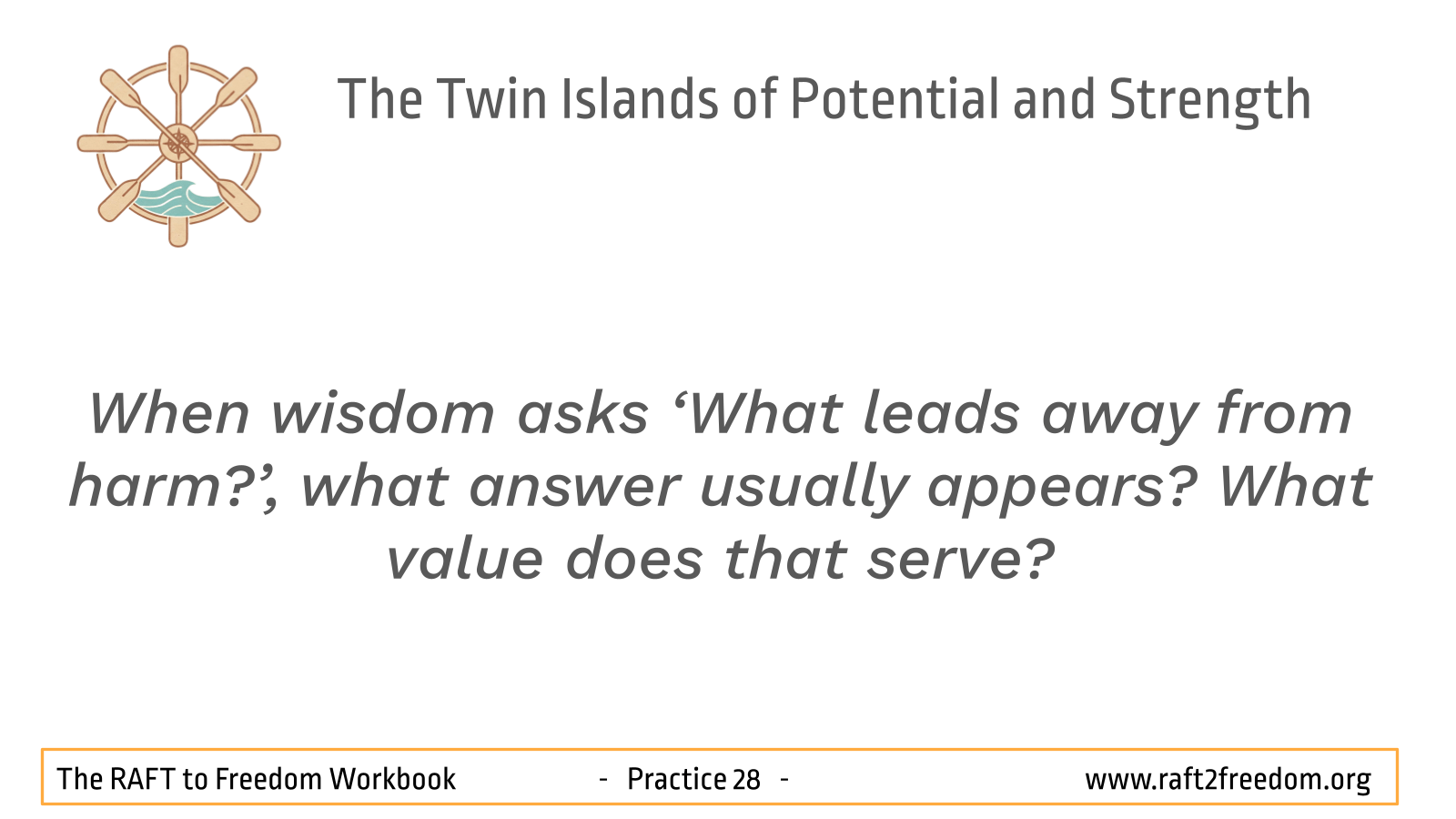28 – The Five Defenders of freedom
There are these five faculties: faith, energy, mindfulness, collectedness, wisdom.
~ Gotama (the Buddha)
The five faculties are interdependent: confidence inspires energy; energy supports mindfulness; mindfulness steadies concentration; concentration allows wisdom to arise; wisdom in turn strengthens confidence.
Bikkhu Bodhi

Episode 28 – The twin Islands of ‘Potential’ and ‘Strength’
An AI generated ‘deep dive’ into this aspect of the RAFT to Freedom
What Gotama taught about the Five Defenders of freedom
Having explored that craving amplifies suffering, and cultivated the ‘Appropriate Response’, the heart-quality of ‘Befriending’, we now turn to developing the specific inner strengths required for the second stage of our journey – the challenging work of ‘A’ to Abandon.
In his early talks, Gotama repeatedly named five trainable qualities as the heart of practice:
- Confidence (Faith) (saddhā)
- Courageous Effort (viriya)
- Therapeutic Mindfulness (sati)
- A Gathered Mind (Focus) (samādhi)
- Discernment (paññā)
These are not five separate items on a checklist but a dynamic, interconnected system of inner resources. They are presented in two ways. As ‘Faculties’, they are potentials that can be weak or strong, balanced or out of balance. As ‘Powers’, these same Five Defenders have become steady and unshakeable, resilient under pressure and reliable in daily life.
For our purposes, we will explore the ‘faculties and powers’ together, calling them the ‘Five Defenders’, because when cultivated, they provide the strength and inner authority needed to avoid being swept away by habitual reactions. They defend the raft and make the work of abandoning harmful cravings possible.
Healing the wounds: the surgeon’s tools
To understand the vital role of these ‘Defenders’, we can turn to a powerful simile used by Gotama – that of a person shot with a poisoned arrow. A surgeon is called, who must use a sharp knife to open the wound and a probe to locate and remove the arrow, before extracting the poison completely.
The wound is the way the world impacts the senses; the poison is ignorance; the arrow is craving. The probe, he said, is ‘Healing Mindfulness’, and the knife is ‘Discernment’ (wisdom). The other three ‘Defenders’ provide the necessary support for this delicate operation: the stability to hold steady (a ‘Gathered Mind’), the courage to endure the procedure (‘Courageous Effort’), and the trust that healing is possible (‘Confidence’).
This ancient image speaks directly to the modern insight shared by Iyanla Vanzant:
You can accept or reject the way you are treated by other people, but until you heal the wounds of your past, you will continue to bleed. You can bandage the bleeding with food, with alcohol, with drugs, with work, with cigarettes, with sex, but eventually, it will all ooze through and stain your life. You must find the strength to open the wounds, stick your hands inside, pull out the core of the pain… and make peace with them.
The ‘Five Defenders’ provide the strength and the skilful tools needed for this deep healing work. They allow us to stop merely bandaging the wound and begin the real work of removing the arrow.
In our RAFT to Freedom, these ‘Five Defenders’ are the essential tools and structural reinforcements needed for the demanding work of the second stage of our journey. They are like having:
- Confidence: Strong belief in the raft’s design and destination.
- Courageous Effort: A skilled and energetic crew.
- Healing Mindfulness: A vigilant Captain keeping watch.
- A Gathered Mind: A stabilising keel and ballast system.
- Discernment: Accurate charts and navigational instruments used wisely.
Together, they protect the raft from breaking apart under the stress of jettisoning harmful cargo and navigating the powerful currents of craving.
Imagine the mind as a small crew in shifting weather. ‘Healing Mindfulness’ is the lookout and gatekeeper, watching the horizon and the sense-doors. ‘Discernment’ is the navigator who reads conditions and charts a safe course. ‘A Gathered Mind’ is the ballast and even keel, giving the vessel steadiness so adjustments are possible. ‘Courageous Effort’ is the crew’s strength and perseverance – the willingness to haul a line or take another stroke even when tired. ‘Confidence’ is the compass and morale, reminding the crew why the voyage matters and that safe shores are not a fantasy.
When they work together, comfort-seeking and avoidance are balanced with the courage to meet challenges; choosing freedom becomes simpler than chasing relief.
The Five Defenders of freedom – working together
Confidence – begin with orientation: Start by remembering what truly matters. Name one real thing that makes life worth caring for – perhaps a person you love, a memory of kindness, or a teaching that inspires integrity. Feel the lift that comes from orienting toward what heals. Confidence here is not blind belief; it is the steady decision to lean, again and again, toward what brings freedom.
Confidence reflection: What strengthens your confidence on this journey, and how can hope be nurtured today?
Courageous Effort – take the next wise step: When an urge or craving arises, break it down into something small and possible. Pause. Drink a glass of water. Take three steady breaths. Walk around the block. Phone a supportive friend. Energy does not come from waiting for motivation; it grows each time you take the next doable step.
Courageous Effort reflection: Where is effort most needed right now, and what one small step can be taken in that direction?
Healing Mindfulness – guarding the gate: At the moment of contact, notice the feeling tone: pleasant, unpleasant, or neutral. See the lean – grasping, resisting, or drifting. Label it lightly, without judgment. Mindfulness stands at the gate like a watchful guard, spotting visitors early and deciding who to let in. The acronym MĀRA (Mindful Awareness Responds Appropriately) can help: it reminds us to meet each moment with awareness, not autopilot.
Healing Mindfulness reflection: How is mindfulness helping you to notice and stay present with each feeling tone as it arises?
A Gathered Mind – adding ballast: When the inner sea grows choppy, simplify. Soften the posture. Lengthen the out-breath. Rest attention on a single steady anchor – the breath, the soles of the feet, the contact of the body with the ground. A Gathered Mind is like ballast in a boat: it steadies the vessel, reduces impulsivity, and gives wisdom a stable platform to work from.
Gathered Mind reflection: What helps your mind gather and remain steady when distractions or cravings appear?
Discernment – asking the wise question: In moments of choice, pause to ask: “What leads away from harm right now?” Then name one consequence of indulging and one of abstaining. With clarity, choose the kinder step that serves what you care about most. Discernment cuts through confusion, keeping your choices aligned with freedom.
Discernment reflection: What values or perspectives guide your discernment when choosing freedom over old patterns?
Let them work together: In the heat of a trigger, the Five Defenders act as a team:
- Healing Mindfulness recognises the tilt and feeds clear data to…
- Discernment, which points out what matters most…
- A Gathered Mind steadies attention to hold the course…
- Confidence keeps the compass true…
- Courageous Effort takes the next wise step.
Practised often, these Five Defenders become natural allies. They shift from fragile faculties into reliable powers – from five potentials to five embodied strengths – the Five Defenders of freedom standing steady under pressure.
The guiding principle
Use whatever serves freedom. Confidence, Effort, Mindfulness, Collectedness, and Discernment can be strengthened by ancient teachings and modern therapies alike. Let go of ideology; keep only what builds the raft and carries you toward freedom.
Together, the Five Defenders do not just protect – they propel. Each small act of confidence, effort, mindfulness, steadiness, and discernment builds strength. Over time, they become embodied and work as one, carrying you across the changeable waters of craving, aversion and confusion towards the far shore of freedom.
Self-reflections
- Which defender is observed to be most available at present? Which quality appears to need more care and attention?
- What simple condition (sleep, food, connection, movement) would strengthen the weaker quality?
- Reflecting on a recent difficult episode, which defender, if any, was observed to arise first?
- What conditions or recollections reliably allow confidence to re-emerge when the mind is fogged by doubt?
- How is courageous effort experienced when it arises from kindness rather than pressure? What single next step would honour that?
- When wisdom asks ‘What leads away from harm?’, what answer usually appears? What value does that serve?
Journaling prompts
- Defence assessment: For each of the Five Defenders, write a sentence about where its presence is currently seen in your life, and one condition that strengthens it.
- Investigating a trigger: Map the sequence of a recent wobble: note the initial sensory contact, the feeling tone that arose, the subsequent urge, which defender (if any) became present, the action taken, and the result. Then, rewrite the sequence, imagining how an earlier arrival of a specific defender might have altered the outcome.
- A record of confidence: List three experiences, observations, or teachings that serve as reminders of the value of this path. This record can be reviewed when motivation is observed to be low.
- Energy micro-steps: Plan three tiny, doable actions to take the next time a craving visits. Report on what happened.
- Gatekeeper log: For one day, every time an urge appears, record what the gatekeeper (mindfulness) noticed first (body, thought, feeling tone) and how quickly it was noticed.
- Ballast practice: Choose a five-minute gathering practice (for example, focusing on the breath) and track mood/impulse levels before and after for a week.
- The wise question: After a choice is made, write two lines: ‘What value did that serve?’ and ‘What would serve better next time?’.
Supporting Material: scientific and philosophical perspectives
For those interested in the scientific and philosophical underpinnings of the Five Defenders, the following overview highlights some key connections.
- Neuroscience: The Five Defenders track with known neural systems. Confidence/hope influences motivation and expectancy networks; Courageous Effort recruits prefrontal control; Mindfulness enhances attention and interoceptive accuracy; a Gathered Mind engages emotion-regulation pathways and reduces limbic reactivity; Discernment reflects integrative, value-based decision-making across prefrontal structures. Trained together, these systems increase tolerance of unpleasant cues and reduce cue-driven behaviour – exactly the shift needed to abandon harmful habits.
- Psychology: The defenders map cleanly to established approaches. Self-efficacy and Motivational Interviewing support confidence; behavioural activation and DBT’s opposite action train courageous effort; MBCT/MBSR/MBRP cultivate mindfulness and a gathered mind; ACT and CBT operationalise discernment through values clarification, defusion, and cognitive re-appraisal. These are inclusive tools on the raft – helpful methods, not identities.
- Philosophy: Virtue traditions across cultures prize dispositions like courage, steadiness, discernment, and fidelity – close cousins of the Five Defenders. Philosophically, the point is to become the kind of person for whom wholesome actions feel natural and unwholesome actions feel out of character. The Five Defenders name that becoming in a form that is practicable day by day.
Remember to remember
The Five Defenders are capacity, not theory. When rough water rises, let the gatekeeper notice the first tremor. Let ballast gather the mind. Ask the wise question and take one energetic next step in the direction that confidence points to. Remember that these are the surgeon’s tools for the healing of the heart. Let Mindfulness be the probe and Discernment the knife, supported by the steady, Courageous Confidence needed for the operation to succeed.
Practised together, these qualities shift from potentials to powers – unshaken by their opposites, reliable under pressure, and naturally allied to kindness. They defend the raft through the second stage of the journey – the work of abandoning and readying the heart for deeper calm and insight in the stages ahead.
The practice is like a cart with five wheels. If one is missing, it cannot run. Confidence, effort, mindfulness, concentration, and wisdom — all must work together.
Ajahn Chah
By effort, vigilance, restraint and self-control, let the wise one make for themselves an island which no flood can overwhelm.
~ Dhammapada
Sutta references
- Indriya-Vibhaṅga Sutta (SN 48.10) – Analysis of the Faculties
- Summary: Defines the Five Faculties as – faith, energy, mindfulness, collectedness, wisdom – and describes how each functions in practice and how they balance one another. The canonical ground for treating the ‘defenders’ as trainable capacities that can mature into powers.
- Bala Sutta (AN 5.14) – The Powers
- Summary: Presents the same five as powers that, when fully developed, are unshaken by their opposites (faith by doubt, energy by laziness, and so forth.). The faculties become dependable defenders under pressure.
- Cūḷamālukya Sutta (MN 63) – The Shorter Discourse to Mālukyaputta
- Summary: Contains the powerful simile of a man shot with a poisoned arrow who refuses treatment until he knows every detail about his attacker. It illustrates the urgency of addressing the immediate problem of suffering (removing the arrow of craving) rather than getting lost in metaphysical speculation. This provides the canonical source for the ‘poisoned arrow’ metaphor used to frame the healing work of the Five Defenders.
| RAFT to Freedom © 2025 by Dr Cathryn Jacob and Vince Cullen is licensed under CC BY-NC-SA 4.0. To view a copy of this license, visit https://creativecommons.org/licenses/by-nc-sa/4.0/ |
